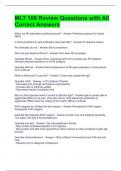Exam (elaborations)
MLT 106 Review Questions with All Correct Answers
- Course
- Institution
MLT 106 Review Questions with All Correct Answers When are Rh antibodies usually produced? - Answer-Following exposure to foreign RBCs In what conditions do IgG antibodies react optimally? - Answer-37 degrees Celsius Rh antibodies do not: - Answer-Bind complement Who can give blood to Rhn...
[Show more]



